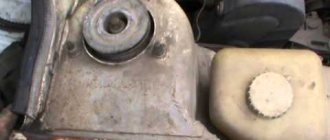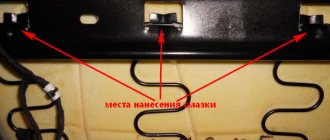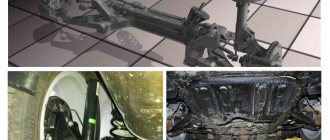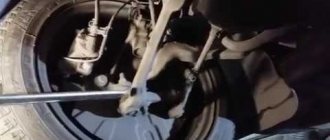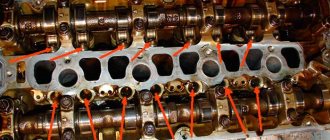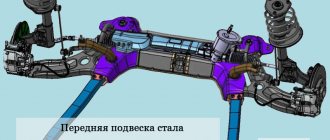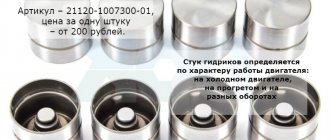If the front suspension of your car is knocking, you have to go to a service center and look for the problem. But the issue is not always resolved during diagnosis. Firstly, the qualifications of the technicians may not be enough to detect the problem. Secondly, some elements of the chassis cannot be checked without disassembly. So you need to learn to look for problems based on the nature of the sound. A knock in the front suspension may occur when hitting bumps. We have already talked about such cases; they are not difficult to find. This type of problem can be found quite simply if you drive into a pit and ask an assistant to shake the car. At this time, it is enough to hold on to various suspension parts or release the silent blocks. This will help you find exactly the part that knocks when hitting obstacles.
If the knocking noise in the forward drive occurs on a flat road, the problem is more subtle. Finding it will not be easy, especially without experience and knowledge in this matter. It should be remembered that knocking can occur in different ways. It is by the nature of the sound that you can often understand what is knocking in your car. However, the concept of a smooth road in Russia is quite relative. So we will consider the issues of knocking of various parts, including sounds on small irregularities and smooth holes on the road. Knocks are also possible on a perfectly flat road. In this case, any rotation element may become unscrewed, which causes a knocking sound simply when turning the wheel. But it’s worth sorting everything out in order. There are a number of reasons that are worth checking if your car exhibits a clunking sound on relatively smooth roads in the suspension area.
CV joints are the main instigators of knocking noises during rotation
Often problems are solved by replacing CV joints. This is a rotary mechanism in the external version and an object of independent transmission of torque in the internal version. If before the mystical knocking sound appeared when turning, you did not hear crunching sounds, then the internal CV joint may be to blame. The outer one fails more often, but before failure it begins to crunch when turning. You can check the part as follows:
- put the car in the pit, turn off the speed and turn on the handbrake for easy access to the axle shafts and other suspension elements in the front of the car;
- check for play on the axle shafts by loosening them from top to bottom or in different directions, then check the play by pushing the axle shaft inside the CV joint and back;
- if there is play, the parts have fallen apart, they need to be replaced, you should buy only high-quality spare parts to carry out the necessary repair processes;
- Before replacing, do not forget to drain the oil from the gearbox, since otherwise it will simply flow out through the holes that appear at the site where the CV joints are installed.
The process of replacing internal CV joints is quite complicated. Interestingly, the main reason for parts failure is a torn boot. A part that costs a hundred rubles damages an expensive mechanism that is very difficult to replace. So it is worth monitoring the condition of the anthers and always changing them if necessary.
Lada Kalina knocking on the right side
front struts need to be looked at
front struts need to be looked at
What does large longitudinal play of the drive mean? Do the grenade bodies play longitudinally or does the axle shaft itself move in the outer grenade? I had a problem, the grenade began to crunch periodically, I didn’t look hard for the reason, I bought a new one, when replacing it, it turned out that the retaining ring, which from the inside of the axle shaft limits the depth of the CV joint on the axle shaft, jumped out of the slot and slid a little towards the box, so the axle shaft started move freely along the splines and go a little deeper into the grenade, longitudinal play of the axle shaft appeared, therefore the axle shaft began to cling to the outer CV joint body and a characteristic crunch appeared under sudden loads during straight-line movement, it does not sound like a knock
What does large longitudinal play of the drive mean? Do the grenade bodies play longitudinally or does the axle shaft itself move in the outer grenade? I had a problem, the grenade began to crunch periodically, I didn’t look hard for the reason, I bought a new one, when replacing it, it turned out that the retaining ring, which from the inside of the axle shaft limits the depth of the CV joint on the axle shaft, jumped out of the slot and slid a little towards the box, so the axle shaft started move freely along the splines and go a little deeper into the grenade, longitudinal play of the axle shaft appeared, therefore the axle shaft began to cling to the outer CV joint body and a characteristic crunch appeared under sudden loads during straight-line movement, it does not sound like a knock
- Replacing an additional brake light for a Volkswagen Polo sedan
- How to get rid of a grant
- VAZ 2108 installation of idle air plug
- Suzuki Grand Vitara 2008 front control arms which are better
- VAZ 2112 does not drive
Ball joint - knocking in the suspension of different characters
There is a part in the car suspension that is difficult to check. If it knocks, it happens precisely on small and unnoticeable irregularities. The ball loses its lubricant and begins to move very difficultly inside the seat. This causes sounds like creaking, light knocking, and annoying rattling. An element fails for the following reasons:
- just natural wear of the part, which occurs every 100,000 kilometers; during operation, the mechanism wears out, lubricant comes out, and efficiency decreases;
- the support begins to knock quite unexpectedly, the intensity of the sounds quickly increases, so it is better to promptly replace the element;
- when installing a low-quality support, a not very pleasant process occurs - after a few thousand kilometers, extraneous sounds appear that are unpleasant to listen to;
- Also, a torn boot is one of the main causes of problems in this part of the car, so you should constantly look at the rubber bands and their integrity.
The ball joint is very difficult to diagnose. To check it, it must be removed, which cannot be done without the help of a professional service. That is why they often do not sin on it when going through other suspension parts. It may well happen that you change half of the suspension until you get to the knock directly in the ball joint.
Struts and strut supports are a problem for every car
Even high-quality and reliable racks begin to struggle with unevenness and knock after prolonged use. For a Chinese spare part, a long service life of 1000 kilometers is considered, for an original Japanese or European one - 15-20 thousand. Struts and upper supports regularly fail on cars in Russia, and the reasons for this can be very different:
- the strut itself rarely fails completely; when the car is rocking, creaking and extraneous sounds will be heard, and the knock will be heard throughout the entire suspension at once;
- the support in most cases fails at the moment when the support bearing breaks, this happens in the event of a sudden collision with large uneven roads;
- Perhaps a simple tightening of the support or shock absorber fastening at the top point will help you; you need to check all fastening elements;
- If the struts break down, they may leak, which will be visible on the body, but this is not a prerequisite, but simply a recommendation for additional diagnostics of the suspension element.
Operating principle
On the Lada Kalina, MacPherson suspension has improved ride quality. Starting with Kalina, all new AvtoVAZ models began to be equipped with MacPherson strut suspension. When driving, the level of impact of a bad road on the body is much more effectively reduced, making driving a car much more comfortable than, for example, a VAZ 2109, where a similar type of suspension is installed.
Thus, the independent MacPherson suspension consists of two axle shafts, allowing the wheels to be practically independent of each other. This means that the wheels, when one of them hits a bump, a depression or something else, do not change the level of inclination, as is the norm in semi-independent and dependent suspensions.
Differences between the front suspension of Kalina and previously produced AvtoVAZ cars
All AvtoVAZ cars had a MacPherson strut suspension at the front, but it was significantly different from those used in the 70s, 80s and 90s by Ford, Fiat, Volkswagen, etc. So, the main differences between the MacPherson strut suspension and the suspensions of Lada models until 2004 are concluded as follows:
- Instead of a bearing, a bushing is mounted in the MacPherson.
- In MacPherson, the ball bearing has a larger radius, and the design also differs. Now it is located in the upper part between the support and the spring element in a compressed state, which perfectly helps to remove knocks when moving.
- When the wheels turn, the front suspension strut, or rather its body, rotates with the spring simultaneously. When this happens, the shock absorber rod remains motionless.
The steering rack is a quiet, separate element with sophisticated diagnostics
It often happens that after reassembling the entire chassis, it is time to check the steering rack. By moving the steering wheel left and right, you will hear small knocks if the rack has already begun to wear out. But this does not mean at all that it knocks during operation. It is difficult to give general recommendations here; there are different recommendations for owners of different cars:
- It’s worth visiting specialized forums and reading information about how and when the steering rack fails, how you can check and fix it;
- tightening the steering rack is a solution for a few days; soon it will start knocking again if a problem is identified with this particular element of the car;
- the knock of the rack is often a distinct feedback on the steering wheel, as well as on the body in the area where the control pedals are attached, so diagnosis will not be difficult;
- Sometimes steering tips or rods knock, which is more difficult to check, but you can perform a full diagnosis in a pit without any problems or inaccuracies.
The steering system likes to knock in domestic cars, as well as in cars older than 10 years. Changing the steering rack is very difficult due to the high cost of spare parts and the rather inconvenient location in many cars. Therefore, they prefer to perform this process on a service. Professionals will complete all tasks quite simply and quickly.
Silent blocks in the front of the car - replacement check
A very important element of the front suspension, which can knock in the most unusual way, is a set of silent blocks. The most common knocking sounds are the rear silent blocks of the front suspension arms, as well as the support silent blocks of the stabilizer, which are attached to the body. The whole problem is solved by replacement, there is no point in diagnosing for a long time - it is better to change the part. Failure occurs for the following reasons:
- the rubber simply breaks due to increased loads, it does not withstand too much pressure and is deformed under the influence of the connections of the suspension arms;
- The silent block stops turning freely in the right place, there is no flexibility in the suspension, and the levers knock due to the lack of the required maneuver;
- the rubber has worn through, worn out and decreased in size, so metallic sounds are heard from the chassis, which are difficult to diagnose;
- It is necessary to pay attention to the fastenings of silent blocks; often replacing them turns out to be difficult due to preliminary unskilled work with suspension parts.
You can check while driving whether the rear silent blocks of the front control arms are knocking. You need to place your foot directly on the floor and listen to whether there is a knock on your foot. The same procedure should be done on the passenger seat. The stabilizer support bushings are checked by placing your foot or hand on the part of the body behind the pedals. However, if you have suspicions, you can simply change this element. We invite you to watch a short video with self-diagnosis of the Hyundai Solaris suspension:
Brake calipers - an exclusive problem
Only in some car models with disc brakes in the rear, the brake calipers become loose or simply play. This is problem number one for all budget cars with rear disc brakes. It is the budget nature of fasteners that often causes parts to fail. It is very interesting that calipers can be an invisible cause of knocking, that is, very difficult to diagnose. You will have to perform the following procedures:
- first, you can try to pull the caliper with your hands while the wheel is installed; perhaps the parts of the mechanism are hitting the disc, everything should be tightly screwed;
- Next, you should remove the wheel and carry out manual diagnostics of all possible fastenings of this unit; you should tug the mechanism with your hands to understand the absence of play;
- the next step should be to disassemble the caliper to determine the loose parts, but doing this without experience is not recommended, as many problems can be found;
- when disassembling, you should pay special attention to the quality of tightening of each module and each bolt, this is what can tell you where the knocking problem lies;
- when reassembling, pay attention to the pads; it is quite possible that they are worn out or deformed, and are simply knocking in the places where they are installed during operation.
Let's sum it up
It is worth using various methods to test equipment before replacing. Otherwise, because of one knock, you can change half of the suspension without eliminating the cause of the problem. Therefore, you should always approach diagnostics from different angles and use the services of testing suspension parts at several service stations. You can change parts only if you are sure that certain mechanisms are faulty. You should approach the issue of repair with full understanding so as not to spend too much money on this process. Many novice drivers simply buy every part that they are guilty of, and as a result, repairs are very expensive.
There are certain difficulties in diagnosing the chassis of a modern car. It is not at all clear which element may be causing the knocking. There are a number of possible options, they are all interconnected, and even analysis does not answer the question. Therefore, it is very difficult to use the full picture of the breakdown to purchase the spare parts necessary for repair. Sometimes you have to change parts just at random, not getting the result on the first try. There are various repair options available, but to do so you need to pinpoint the problem. How do you usually diagnose and repair the chassis of your car?
A knock in the front suspension on small bumps is one of the signs that some of the chassis parts are damaged or almost completely worn out. Novice motorists, without much hesitation, take their car to a service station for diagnostics and shell out considerable sums for repairs. However, there is no guarantee that the knocking will disappear and its source will be found. You can not only identify but also eliminate most of the causes that cause knocking on your own.
The rebound racks are knocking viburnum
The reason for the knocking bothers me, and most of all on small bumps and small suspension strokes.. Here is what I found on the SAAZ website about rebound impacts, where a person asks the following question: On my Kalina, the front springs are knocking on rebound, they changed it according to guarantees because the car fell under 38 AvtoVAZ regulations. But the knocking did not go away, and this problem is not the first one on the Lada Kalina Club forum, not a single page on this topic has been written down and more than one topic has been started https://forum.ladakalina.ru/viewforum.php?f=11 comment situation, please, maybe I’m just driving incorrectly, or, as the dealer told me, Kalina is a car with Euro properties and is designed for driving on good roads?
Clarification is required: at what amplitudes is knocking observed? Most likely we are talking about the knock of the suspension on rebound at huge amplitudes, i.e. then, when the wheel falls into a hole or when driving through an artificial bulge (“speed bump”), the stand is still in a very extended rod position. Because the strut in a MacPherson-type suspension is, in addition to the damping and guiding element, also an element that limits the suspension travel, the knock is caused by the operation of the “hydraulic buffer” located in the strut. The “hydraulic buffer” is designed to absorb the impact energy of the suspension travel limiters; approximately 20 mm before the full rebound stroke, the water in the cylinder is “locked” by the plunger. The “hydraulic buffer” allows you to reduce the impact energy by approximately 30%, but is not able to completely eliminate the impact, and, as a result, the operation of the “hydraulic buffer” is accompanied by a “water hammer” with a corresponding sound.
According to the regulations of the JSC (form of organization of a public company; joint stock company)
"AVTOVAZ", the knock of the suspension on rebound at the highest suspension travel on rebound is not a drawback, and is justified by the design individuality of the suspension.
All global automakers that use MacPherson-type suspensions are faced with this problem (and especially those who find themselves in Russia, their “short-travel” suspensions are simply not adapted to off-road conditions). And each of them solves it differently: some use a “soft” buffer (eliminating an iron strike, but not reducing the impact energy), others use similar “hydraulic buffers”, but the most complex and, therefore, the most expensive, You can also increase the damping force of the rebound strut to reduce impact energy, but this will affect comfort. We are currently working on reducing the noise level when the hydraulic buffer is activated. It should be noted that the solution to this issue is directly related to the suspension elements, namely the design of the support and spring.
I don’t understand which of us asked this question, if this has already been discussed, I apologize in advance.
The reason for the knocking also bothers me, and most of all on small bumps and small suspension moves..
I had a SAAZ 1118. The feeling of riding a cart never left me for a minute. Most of the knocks went away after replacing the struts, but small knocks
